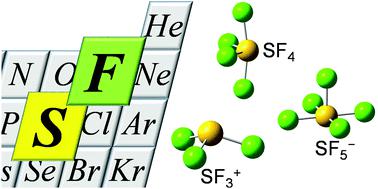当前位置:
X-MOL 学术
›
Dalton Trans.
›
论文详情
Our official English website, www.x-mol.net, welcomes your feedback! (Note: you will need to create a separate account there.)
Recent advances in sulfur tetrafluoride chemistry: syntheses, structures, and applications
Dalton Transactions ( IF 4 ) Pub Date : 2021-09-02 , DOI: 10.1039/d1dt02704b Kazuhiko Matsumoto 1 , Michael Gerken 2
Dalton Transactions ( IF 4 ) Pub Date : 2021-09-02 , DOI: 10.1039/d1dt02704b Kazuhiko Matsumoto 1 , Michael Gerken 2
Affiliation

|
Sulfur and fluorine occupy crucial positions in main group chemistry because these two elements form a variety of compounds with versatile bond modalities and unique functionalities. Among sulfur–fluorine compounds, the importance of SF4 and its derivatives is recognized in the literature. The amphoteric nature of SF4 results in its rich Lewis acidic and basic reactivities; the reactions with F− acceptors and donors yield [SF3]+ and [SF5]− salts, respectively. Lewis basic molecules can also form adducts with SF4 via various interaction motifs. The deoxofluorinating properties of SF4 have been used by organic chemists to selectively introduce fluorine atoms in specific substrates, extending also to industrial applications. Although the properties and reactivity of SF4 have been studied since its first synthesis, the recent progress in the SF4-related chemistry is striking, involving various fields of chemistry. In this Frontier article, recent advances, mainly the last ten years, in syntheses and structures of SF4-related compounds including its cationic and anionic derivatives and adducts with Lewis bases are concisely reviewed. Their uses in fundamental and applied inorganic chemistries are also described.
中文翻译:

四氟化硫化学的最新进展:合成、结构和应用
硫和氟在主族化学中占据关键位置,因为这两种元素形成了多种具有多种键合形式和独特功能的化合物。在硫氟化合物中,SF 4及其衍生物的重要性在文献中得到了认可。SF 4的两性性质导致其具有丰富的路易斯酸性和碱性反应性;与F -受体和供体的反应分别产生[SF 3 ] +和[SF 5 ] -盐。路易斯碱性分子也可以通过各种相互作用基序与 SF 4 形成加合物。SF 4的脱氧氟化性能已被有机化学家用于在特定基材中选择性地引入氟原子,也扩展到工业应用。尽管SF 4的性质和反应性自其第一次合成以来就一直在研究,但SF 4相关化学的最新进展是惊人的,涉及化学的各个领域。在这篇 Frontier 文章中,简要回顾了 SF 4相关化合物(包括其阳离子和阴离子衍生物以及与路易斯碱的加合物)的合成和结构方面的最新进展,主要是最近十年。还描述了它们在基础和应用无机化学中的用途。
更新日期:2021-09-09
中文翻译:

四氟化硫化学的最新进展:合成、结构和应用
硫和氟在主族化学中占据关键位置,因为这两种元素形成了多种具有多种键合形式和独特功能的化合物。在硫氟化合物中,SF 4及其衍生物的重要性在文献中得到了认可。SF 4的两性性质导致其具有丰富的路易斯酸性和碱性反应性;与F -受体和供体的反应分别产生[SF 3 ] +和[SF 5 ] -盐。路易斯碱性分子也可以通过各种相互作用基序与 SF 4 形成加合物。SF 4的脱氧氟化性能已被有机化学家用于在特定基材中选择性地引入氟原子,也扩展到工业应用。尽管SF 4的性质和反应性自其第一次合成以来就一直在研究,但SF 4相关化学的最新进展是惊人的,涉及化学的各个领域。在这篇 Frontier 文章中,简要回顾了 SF 4相关化合物(包括其阳离子和阴离子衍生物以及与路易斯碱的加合物)的合成和结构方面的最新进展,主要是最近十年。还描述了它们在基础和应用无机化学中的用途。


























 京公网安备 11010802027423号
京公网安备 11010802027423号